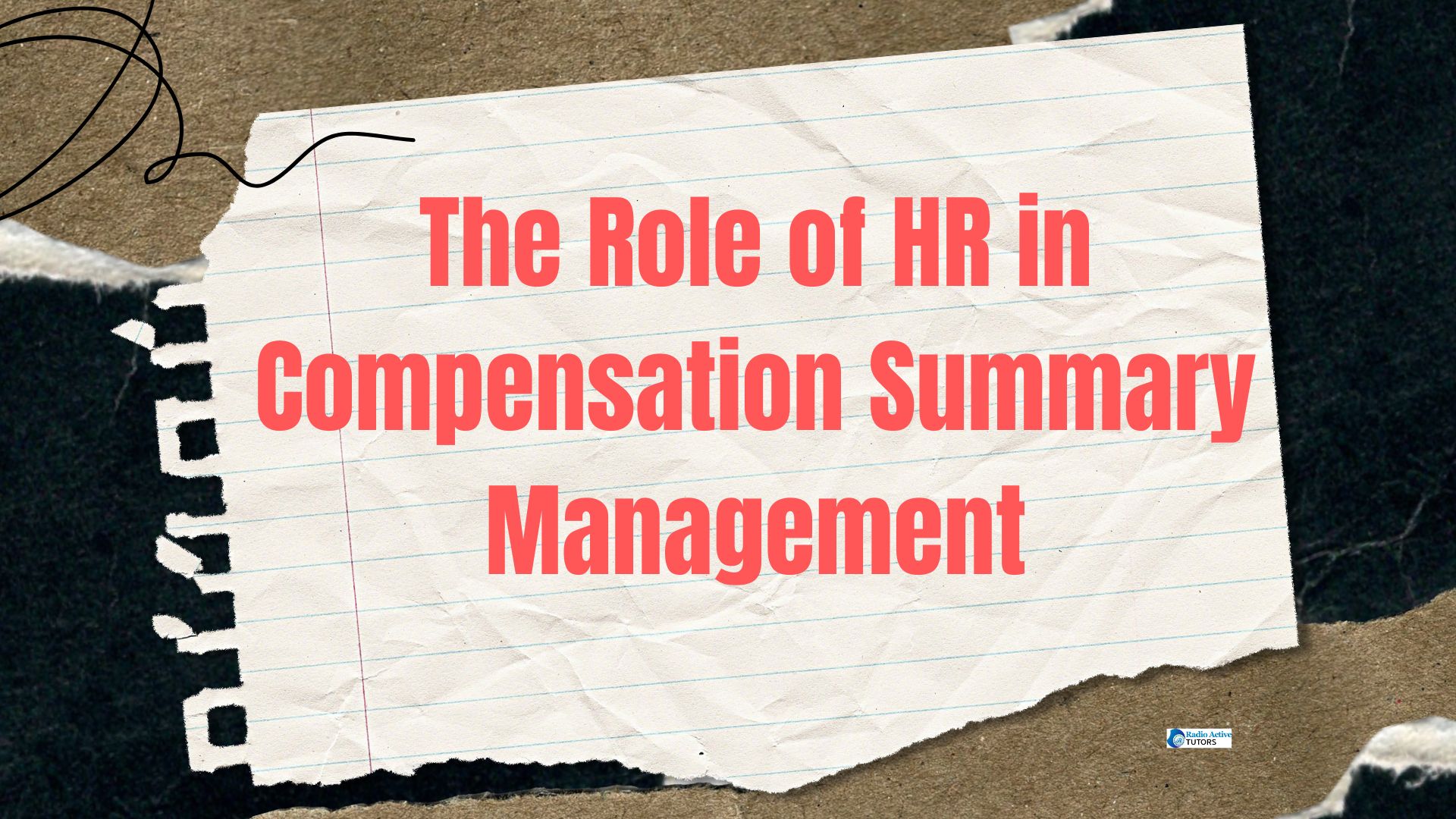Table of Contents
I. Introduction
II. Understanding Employee Compensation Summaries
III. Components of Employee Compensation Summaries
IV. Crafting Effective Employee Compensation Summaries
V. Communicating Compensation Changes in Employee Compensation Summaries
VI. Legal Considerations and Compliance in Employee Compensation Summaries
VII. The Role of HR in Compensation Summary Management
VIII. Measuring the Effectiveness of Employee Compensation Summaries
IX. Case Studies and Success Stories
X. Cultivating a Culture of Transparency and Trust in Employee Compensation Summaries
XI. Frequently Asked Questions (FAQs)
I. Introduction
- Why Employee Compensation Summaries Matter

Employee compensation summaries hold significant importance in the realm of employee compensation management. These summaries serve as crucial tools for both employers and employees, providing a comprehensive overview of the various components of an employee’s compensation package. By clearly outlining elements such as salary, bonuses, benefits, and other forms of compensation, these summaries ensure transparency and facilitate understanding between employers and employees. Furthermore, they play a pivotal role in fostering trust and satisfaction within the workforce, as employees feel valued and empowered when they have a clear understanding of their total compensation.
Additionally, compensation summaries help companies align their compensation strategies with organizational goals and industry standards, ultimately contributing to employee retention, motivation, and overall organizational success. Thus, employee compensation summaries are not merely administrative documents but essential instruments for promoting fairness, transparency, and mutual trust in the employer-employee relationship.
II. Understanding Employee Compensation Summaries
In the realm of employee compensation management, understanding the definition and purpose of compensation summaries is paramount. These summaries are comprehensive documents that outline the various elements comprising an employee’s compensation package, including salary, bonuses, benefits, and other forms of remuneration. Their purpose is twofold: first, to provide employees with a clear and transparent breakdown of their total compensation, ensuring they have a thorough understanding of the value they receive from their employer. Secondly, compensation summaries serve as a tool for employers to effectively communicate their compensation policies and practices, fostering trust, satisfaction, and alignment with organizational goals.
By defining and elucidating the purpose of compensation summaries, employers can enhance transparency, mitigate misunderstandings, and promote a positive employer-employee relationship grounded in mutual understanding and appreciation.
- Importance of Clear and Comprehensive Employee Compensation Summaries
Clear and comprehensive summaries are of utmost importance in understanding employee compensation summaries. These documents serve as the primary means through which employees gain insight into their total compensation package, including not only monetary aspects like salary and bonuses but also non-monetary benefits and perks. When these summaries are transparent and easily comprehensible, employees can make informed decisions about their careers, financial planning, and overall well-being.
Moreover, clear summaries help to build trust and foster positive relationships between employers and employees, as they demonstrate the organization’s commitment to fairness and transparency in its compensation practices. By ensuring that compensation summaries are both clear and comprehensive, companies can empower their employees, strengthen engagement, and ultimately contribute to a more satisfied and productive workforce.
III. Components of Employee Compensation Summaries
Basic salary stands as a fundamental component within the framework of employee compensation summaries. It represents the fixed amount of money that an employee receives for their work, typically expressed as an annual or monthly figure. This core element forms the foundation of an employee’s compensation package, serving as the baseline for other forms of remuneration such as bonuses, incentives, and benefits. Clear delineation of the basic salary in compensation summaries is essential for both employers and employees, providing clarity and transparency regarding the financial compensation associated with the employee’s role and responsibilities.
Additionally, understanding the basic salary aids employees in assessing their earning potential, planning for financial goals, and evaluating their overall compensation package. Consequently, accurate representation and communication of basic salary within compensation summaries are imperative for fostering trust, satisfaction, and alignment between employers and employees.
Bonuses and incentives serve as dynamic components within the realm of employee compensation summaries, offering additional rewards beyond the basic salary. These supplementary forms of compensation are often linked to individual or collective performance, providing employees with tangible recognition for their contributions to the organization’s success. Within compensation summaries, bonuses and incentives are outlined to provide transparency regarding the criteria for eligibility, the timing of payouts, and the potential amount that employees can earn.
Clear communication of bonuses and incentives not only motivates employees to strive for excellence but also reinforces a culture of meritocracy and performance-driven rewards within the organization. Moreover, by highlighting these additional compensation elements, employers demonstrate their commitment to rewarding and retaining top talent, thereby fostering employee engagement, loyalty, and overall organizational performance.

The benefits package constitutes a vital aspect within the components of employee compensation summaries. It encompasses a range of non-monetary perks and provisions offered to employees in addition to their basic salary and bonuses. These benefits may include health insurance, retirement plans, paid time off, flexible work arrangements, wellness programs, and various other employee assistance programs. In compensation summaries, the benefits package is meticulously detailed to ensure employees have a comprehensive understanding of the resources and support available to them beyond financial compensation.
Clear communication of the benefits package not only helps employees make informed decisions about their overall compensation but also underscores the organization’s commitment to employee well-being, work-life balance, and overall satisfaction. By delineating the benefits package in compensation summaries, employers can attract top talent, enhance employee retention, and cultivate a positive workplace culture centered on employee care and support.
- Stock Options or Equity Grants
Stock options or equity grants represent significant components within the framework of employee compensation summaries. These forms of compensation offer employees the opportunity to acquire ownership or shares in the company, aligning their interests with the organization’s long-term success. In compensation summaries, stock options or equity grants are outlined to provide clarity regarding eligibility criteria, vesting schedules, exercise prices, and potential benefits. By including these details, employers ensure transparency and empower employees to understand the value of their equity-based compensation.
Moreover, stock options or equity grants serve as powerful incentives for employees to contribute to the company’s growth and performance, as they directly participate in the potential financial upside of the organization. Clear communication of stock options or equity grants in compensation summaries not only enhances employee engagement and motivation but also reinforces a sense of ownership and alignment with the company’s goals and objectives.
- Other Forms of Compensation
In addition to basic salary, bonuses, benefits, and stock options or equity grants, there are various other forms of compensation that may be included in employee compensation summaries. These additional forms of compensation can range from performance-based rewards such as profit-sharing or commission structures to non-monetary perks like professional development opportunities, tuition reimbursement, or company-provided amenities. In compensation summaries, these other forms of compensation are detailed to ensure employees have a comprehensive understanding of the total value they receive from their employer.
By transparently communicating these additional benefits, employers not only recognize and reward employees for their contributions but also enhance their overall satisfaction and engagement. Moreover, including these forms of compensation in summaries reinforces the organization’s commitment to supporting employee growth, well-being, and success, ultimately contributing to a positive workplace culture and organizational performance.
IV. Crafting Effective Employee Compensation Summaries
Crafting effective compensation summaries is crucial for ensuring that employees have a clear understanding of their total compensation package and the value they receive from their employer. These summaries should be tailored to the needs and preferences of employees, providing comprehensive and transparent information about various components of their compensation, including basic salary, bonuses, benefits, and other forms of remuneration. To be effective, compensation summaries should be clear, concise, and easily accessible, using language that is easy to understand for all employees.
Additionally, organizations should consider incorporating visual aids, such as charts or graphs, to enhance comprehension and highlight key information. Furthermore, compensation summaries should be updated regularly to reflect any changes in compensation policies or practices, ensuring that employees always have accurate and up-to-date information. By crafting effective compensation summaries, organizations can empower employees to make informed decisions about their careers and financial futures, fostering trust, satisfaction, and engagement within the workforce.
V. Communicating Compensation Changes in Employee Compensation Summaries
- Strategies for Announcing Changes

Effective communication is crucial when announcing changes in compensation within employee compensation summaries. Organizations must employ strategic approaches to ensure that employees understand the reasons for the changes, how they will be affected, and any actions they need to take. One strategy is to provide clear and concise explanations of the changes, highlighting the benefits for both employees and the organization. Additionally, organizations should communicate changes in a timely manner, giving employees ample time to adjust and ask questions.
Utilizing multiple communication channels, such as company-wide meetings, emails, and intranet announcements, ensures that all employees receive the information and have opportunities to seek clarification. Moreover, soliciting feedback from employees and addressing their concerns transparently demonstrates a commitment to fairness and fosters trust in the compensation process. Overall, by employing effective communication strategies, organizations can minimize confusion, alleviate concerns, and facilitate a smooth transition during times of change in compensation practices.
- Addressing Concerns and Questions
Addressing concerns and questions is essential when communicating compensation changes within employee compensation summaries. Organizations should create avenues for employees to express their concerns, ask questions, and seek clarification regarding the changes. This can be achieved through open-door policies, dedicated communication channels, or scheduled Q&A sessions. By actively listening to employees’ concerns and providing transparent and honest answers, organizations can alleviate anxieties and build trust in the compensation process. Additionally, HR and management teams should be prepared to address common questions proactively by providing comprehensive information and guidance.
Furthermore, organizations should acknowledge and validate employees’ feelings about the changes, demonstrating empathy and understanding. By effectively addressing concerns and questions, organizations can foster a supportive and transparent environment where employees feel valued, respected, and engaged in the compensation process.
VI. Legal Considerations and Compliance in Employee Compensation Summaries
- Ensuring Compliance with Labor Laws
Ensuring compliance with labor laws is paramount in the legal considerations and compliance aspect of employee compensation summaries. Organizations must adhere to a myriad of federal, state, and local regulations governing compensation practices to avoid legal repercussions and maintain ethical standards. This includes adhering to minimum wage laws, overtime regulations, anti-discrimination laws, and regulations regarding employee classification.
Additionally, organizations must ensure transparency and accuracy in compensation disclosures to meet legal requirements, such as providing detailed compensation statements and adhering to privacy laws when sharing sensitive employee information. HR and legal departments play a crucial role in staying abreast of evolving labor laws, conducting regular audits, and updating compensation practices accordingly. By prioritizing compliance with labor laws, organizations not only mitigate legal risks but also uphold fairness and integrity in their compensation practices, fostering trust and confidence among employees.
- Confidentiality and Privacy Concerns
Confidentiality and privacy concerns are significant considerations within the legal aspect of employee compensation summaries. Organizations must prioritize safeguarding sensitive compensation information to protect employee privacy and prevent unauthorized access or disclosure. This includes implementing robust data security measures, such as encryption protocols and access controls, to ensure that compensation data is stored and transmitted securely. Additionally, organizations must adhere to privacy laws and regulations, such as the General Data Protection Regulation (GDPR) or the Health Insurance Portability and Accountability Act (HIPAA), when handling compensation information, particularly regarding healthcare benefits.
HR professionals and legal teams play a crucial role in developing and enforcing policies and procedures to maintain confidentiality and privacy in compensation summaries, including educating employees on their rights and responsibilities regarding the protection of their personal information. By addressing confidentiality and privacy concerns proactively, organizations can instill trust and confidence among employees and demonstrate their commitment to ethical and compliant compensation practices.
VII. The Role of HR in Compensation Summary Management

Within the realm of employee compensation summaries, HR plays a pivotal role in overseeing compensation management and ensuring the effective communication of compensation information. HR’s responsibilities encompass various tasks, including designing, updating, and distributing compensation summaries in alignment with company policies and regulatory requirements. HR professionals are tasked with accurately compiling and presenting compensation data, ensuring transparency and consistency across all levels of the organization.
Additionally, HR facilitates communication between management and employees regarding compensation changes, addressing inquiries, and providing guidance on compensation-related matters. Moreover, HR plays a crucial role in monitoring employee feedback, conducting surveys, and analyzing data to assess the effectiveness of compensation policies and practices. By fulfilling these responsibilities, HR contributes to fostering trust, fairness, and satisfaction among employees, ultimately promoting a positive employer-employee relationship and organizational success.
- Collaboration with Management and Finance Teams
In the role of managing employee compensation summaries, HR professionals collaborate closely with management and finance teams to ensure the accuracy, consistency, and effectiveness of compensation practices. This collaboration entails working together to develop and implement compensation strategies that align with organizational goals and financial objectives. HR collaborates with management to understand the specific needs and priorities of different departments or teams, tailoring compensation summaries accordingly. Additionally, HR liaises with finance teams to ensure that compensation data is accurately reflected in financial statements and budgets.
By fostering collaboration between HR, management, and finance teams, organizations can streamline processes, mitigate discrepancies, and ensure that compensation summaries accurately reflect the organization’s financial health and strategic objectives. Ultimately, this collaboration contributes to fostering transparency, trust, and alignment across the organization, enhancing employee satisfaction and organizational success.
VIII. Measuring the Effectiveness of Employee Compensation Summaries
- Employee Feedback and Satisfaction Surveys
Employee feedback and satisfaction surveys play a crucial role in measuring the effectiveness of compensation summaries within organizations. These surveys provide valuable insights into employees’ perceptions, preferences, and satisfaction levels regarding their compensation packages and the communication of compensation information. By soliciting feedback through surveys, organizations can gauge employees’ understanding of their compensation summaries, identify areas for improvement, and address any concerns or discrepancies promptly.
Moreover, feedback from these surveys allows HR and management teams to assess the impact of compensation policies and practices on employee morale, engagement, and retention. By leveraging employee feedback and satisfaction surveys, organizations can continuously refine and enhance their compensation summaries to better meet the needs and expectations of their workforce, ultimately fostering a positive workplace culture and driving organizational success.
- Analyzing Retention Rates and Employee Turnover
Analyzing retention rates and employee turnover is an essential aspect of measuring the effectiveness of compensation summaries within organizations. High turnover rates can signal dissatisfaction or disengagement among employees, which may be influenced by factors such as inadequate compensation or a lack of transparency in compensation practices. By tracking retention rates and turnover, organizations can assess the impact of their compensation summaries on employee retention and identify any areas for improvement.
A decrease in turnover rates following the implementation of clear and comprehensive compensation summaries indicates that employees feel valued, fairly compensated, and engaged with their work. Conversely, an increase in turnover may indicate that adjustments are needed to better align compensation practices with employee needs and expectations. By analyzing retention rates and turnover, organizations can gain valuable insights into the effectiveness of their compensation summaries and take proactive measures to enhance employee satisfaction and retention.
IX. Case Studies and Success Stories
Case studies and success stories serve as powerful tools within employee compensation summaries, providing real-life examples of how effective compensation strategies have positively impacted individuals or teams within the organization. These stories highlight specific instances where employees have been rewarded for their contributions, whether through bonuses, promotions, or other forms of recognition. By showcasing these success stories, organizations not only celebrate the achievements of their employees but also demonstrate the tangible benefits of their compensation practices.
Moreover, case studies offer valuable insights into how compensation summaries can be tailored to meet the needs and preferences of different employees, showcasing best practices and innovative approaches. By incorporating case studies and success stories into compensation summaries, organizations inspire and motivate employees, reinforcing a culture of excellence and recognition while fostering transparency and trust in compensation practices.
X. Cultivating a Culture of Transparency and Trust in Employee Compensation Summaries

- Building Open Channels of Communication
Building open channels of communication is integral to cultivating a culture of transparency and trust in employee compensation summaries within organizations. Transparent communication fosters an environment where employees feel comfortable discussing compensation-related matters, seeking clarification, and providing feedback. By establishing open channels of communication, organizations demonstrate their commitment to transparency and fairness in compensation practices. This transparency not only enhances employees’ understanding of their compensation packages but also fosters trust in the organization’s leadership.
Moreover, open communication allows for proactive addressing of concerns, resolving discrepancies, and soliciting input from employees regarding compensation-related decisions. Overall, by prioritizing open channels of communication, organizations can create a culture of transparency and trust that strengthens the employer-employee relationship and contributes to a positive workplace environment.
- Fostering Trust Through Consistent and Honest Practices
Fostering trust through consistent and honest practices is essential in cultivating a culture of transparency and trust in employee compensation summaries within organizations. Consistency in compensation practices ensures that employees are treated fairly and equitably, regardless of their role or tenure within the organization. By adhering to consistent practices, organizations demonstrate their commitment to fairness and integrity in compensation decisions.
Additionally, honesty in communication regarding compensation-related matters builds trust between employees and leadership. When employees feel that they are being provided with accurate and truthful information about their compensation, they are more likely to trust the organization and its leadership. Furthermore, honesty in compensation practices fosters a sense of transparency, empowering employees to make informed decisions about their careers and financial futures. Overall, by prioritizing consistency and honesty in compensation practices, organizations can foster a culture of transparency and trust that strengthens the employer-employee relationship and contributes to a positive workplace environment.
XI. Frequently Asked Questions (FAQs)
- What should be included in an employee compensation summary?
- How often should Employee Compensation Summaries be updated?
- How can companies ensure confidentiality when sharing compensation information?
- What steps can HR take to address employee dissatisfaction with compensation?
- Are there any legal requirements regarding the distribution of compensation summaries?
- How can companies effectively communicate changes in compensation packages?
- What role does employee feedback play in shaping compensation policies?
- How can Employee Compensation Summaries contribute to employee retention?
- What are some common mistakes to avoid when creating Employee Compensation Summaries?
- How can companies ensure that Employee Compensation Summaries are accessible to all employees?
